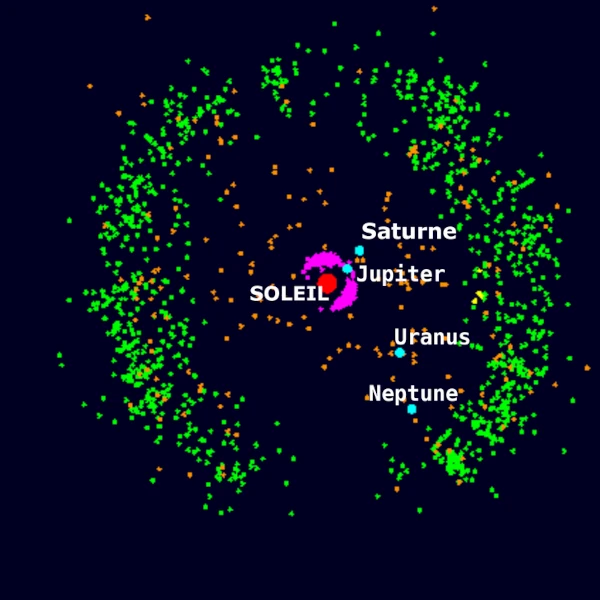
The Kuiper Belt, located approximately between 30 and 50 astronomical units (AU) from the Sun, is an area populated by icy bodies known as trans-Neptunian objects. These objects, ranging from small bodies to dwarf planets like Pluto, represent a natural laboratory for studying the composition and physical evolution of the outer solar system.
The trans-Neptunian objects in the Kuiper Belt are primarily composed of mixtures of ice and rocky materials. The average temperature in this region is extremely low, typically between 30 and 50 K, favoring the stability of volatile compounds that sublimate closer to the Sun.
The dominant ices are mainly composed of water (\(\mathrm{H_2O}\)), carbon monoxide (\(\mathrm{CO}\)), carbon dioxide (\(\mathrm{CO_2}\)), methane (\(\mathrm{CH_4}\)), and nitrogen (\(\mathrm{N_2}\)). These ices are often mixed with complex organic components and silicates, forming a composite structure.
Spectroscopic studies in the near-infrared and ultraviolet by telescopes such as Hubble, as well as instruments on board New Horizons, have made it possible to detect and quantify the presence of these ices. For example, the characteristic signature of methane appears around 1.7 and 2.3 microns, while that of crystalline water is identifiable near 1.5 and 2.0 microns.
The relative abundance of these volatile molecules makes it possible to reconstruct the overall composition and to estimate the surface temperature as well as the texture of the regolith that covers these bodies.
Ices in a cryogenic environment exhibit specific mechanical properties, such as plasticity and fracture resistance, influenced by their crystalline structure (amorphous vs. crystalline). These characteristics affect the possible geological dynamics, such as the cryovolcanic tectonics observed on certain objects like Triton or Pluto.
The porosity of the bodies, often estimated between 10% and 50%, plays a crucial role in their apparent density and internal thermal evolution. The thermal conductivity of mixed ices at low temperatures is low, favoring significant thermal insulation.
| Name | Diameter | Water Ice | Methane (CH₄) | Nitrogen (N₂) | Silicate Rocks | Tholins / Organic C | Others |
|---|---|---|---|---|---|---|---|
| Pluto | 2,376 km | 30% | 0.5% | 1% | 65% | 2% | 1.5% |
| Charon | 1,212 km | 60% | 0% | 0% | 35% | 3% | 2% |
| Eris | 2,326 km | 25% | 2% | 1.5% | 68% | 2% | 1.5% |
| Makemake | 1,430 km | 20% | 2.5% | 2% | 70% | 3% | 2.5% |
| Haumea | 1,632 km | 80% | 0% | 0% | 15% | 2% | 3% |
| Orcus | 917 km | 50% | 0.5% | 0.5% | 44% | 3% | 2% |
| Quaoar | 1,110 km | 40% | 0.5% | 0.2% | 50% | 5% | 4.3% |
| Gonggong | 1,230 km | 45% | 1% | 0.5% | 48% | 3% | 2.5% |
| Sedna | 995 km | 35% | 2% | 1% | 57% | 3% | 2% |
| Ixion | 650 km | 50% | 1% | 0.5% | 44% | 3% | 1.5% |
| Varuna | 668 km | 48% | 0.5% | 0.2% | 47% | 3% | 1.3% |
| Salacia | 854 km | 52% | 0.5% | 0.3% | 43% | 3% | 1.2% |
Source: Synthesis of data from the missions New Horizons, stellar occultations, and spectroscopy (Brown et al., 2012; Barucci et al., 2011; Kiss et al., 2019; Licandro et al., 2021).